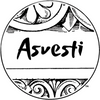Revamp your Space with Asvesti Concrete Primer Paint and Sealer in a DIY Renovation
Renovating a room or space can breathe new life into your environment, and it's often a project that homeowners are eager to tackle themselves. When it comes to enhancing the look of your room, using the right products is essential.
In this article, we will explore using paint sealer, concrete primer paint, and DIY paint primer for a successful DIY renovation.
Paint Sealer
A paint sealer is an important component of any renovation project, as it helps protect your surfaces and extend the life of your paint job. A paint sealer creates a barrier that prevents moisture, dirt, and other contaminants from penetrating the painted surface, whether you're painting walls, ceilings, or even floors.
Before applying paint, make sure your surface is clean and dry. Once you've applied the base coat, which can be regular paint or a specific primer, you can seal it with a paint sealer. This step is particularly important if you're painting in a high-moisture area, like a bathroom or kitchen.
When choosing a paint sealer, consider the type of surface you're working with. Some sealers are designed for specific materials, like wood or concrete, so see to it that you choose the right one for your project. It's also important to select between water-based and oil-based sealers, as they have different properties and drying times. Water-based sealers are typically easier to clean up and have lower levels of harmful fumes.
DIY Paint Primer
Before you start applying your chosen topcoat color, it's important to use a DIY paint primer to prepare your surfaces. A paint primer creates a smooth and uniform surface that enhances the adhesion of your paint, ensuring a professional and long-lasting result.
DIY paint primer is available for different surfaces, including drywall, wood, metal, and more. The type of primer you need depends on the material you are working with. Additionally, there are specialized primers available for specific issues, such as stain-blocking primers for surfaces with water or smoke damage.
Concrete Primer Paint
If you're planning to renovate a room with concrete walls or floors, concrete primer paint is your best friend. Concrete is a porous surface, and without proper preparation, paint might not adhere well or result in an uneven finish. Concrete primer paint is designed to create a solid base for your topcoat, ensuring better adhesion and a smoother final appearance.
To begin your DIY renovation with concrete primer paint, first, clean the surface thoroughly. Any dirt, dust, or loose particles should be removed. Once the surface is clean, apply the concrete primer paint evenly. Allow it to dry according to the manufacturer's instructions. This step is crucial to ensuring that your final paint coat will adhere properly and provide a long-lasting finish.
Concrete primer paint comes in various formulations, including options for both indoor and outdoor use. Select the primer that suits your specific needs and environment. If you're working on a concrete basement floor, for instance, choose a primer designed for that purpose to provide added durability.
DIY Renovation: Get the Essentials
DIY renovation is a rewarding way to transform your living spaces, but it requires the right products and proper preparation. Using paint sealer to protect your surfaces, concrete primer paint to ensure adhesion to concrete, and DIY paint primer to create a smooth canvas are key steps in achieving a successful renovation. With the right materials and a bit of patience, you can achieve a professional-looking transformation that breathes new life into your room or space

 Sold out
Sold out Sold out
Sold out














